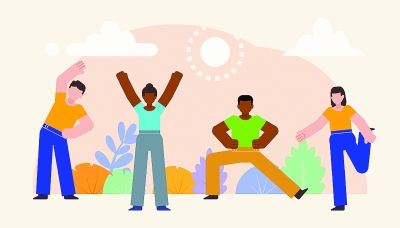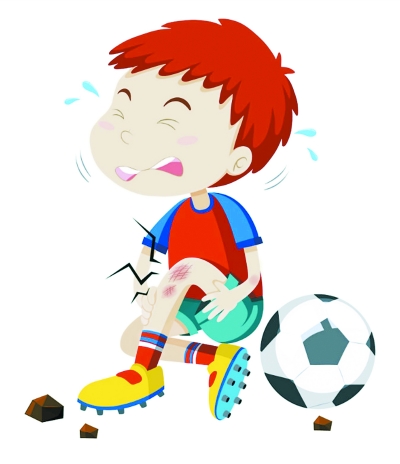

Ma Yong
As the weather warms up and the epidemic eases, many people begin to resume sports. However, the body that has been "sealed" for three or four months is "thawed" at once, and it can’t adapt to high-intensity exercise. Some people were forced to stop their fitness programs just after they started their activities because of sprained ankles, waist flashes, fractures and other accidents. Today, let’s talk about how to exercise scientifically and reasonably and stay away from accidental sports injuries.
Case 1
Last summer, on the spur of the moment, Mr. Wang came to the playground with a few old classmates to play a football match at the reunion of the twentieth anniversary of graduation. Pass, dribble, charge, tackle … … A group of middle-aged people seem to be teenagers again. The game was going on fiercely, and Mr. Wang suddenly turned around, only to feel his knees soft, and his legs slammed, and he fell directly to the ground. Looking at the rapidly swollen knee joint, Mr. Wang was blindsided. Mr. Ma, who knows something about sports injuries among his classmates, rushed to help deal with it. Mr. Wang said gloomily, "I haven’t started yet. How can I get hurt?" While dealing with it, Mr. Ma gave him an analysis: "You haven’t exercised so vigorously for 20 years, and your mind and body can’t remember the previous state. It’ s strange to play without any preparation. "
Case 2
Lao Chen, who weighs 180 Jin, is going to exercise to lose weight. Unable to go to the gym during the epidemic, he chose to run in the suburbs. Although he is a little fat, Mr. Chen’s physical endurance is still good, and there is no problem running 5 kilometers at a time. He ran confidently for a week. On the eighth day, Mr. Chen suddenly felt a little pain in his left leg. It didn’t hurt if he didn’t run, but it hurt when he ran. He had to stop running and go to the hospital to see a doctor. The doctor knocked on his head-on bone with his hand. Mr. Chen said it hurt, and the doctor pressed it with his hand. Mr. Chen said the pain was not obvious. The doctor diagnosed that the head-on bone of Lao Chen’s left leg was probably fractured, and suggested that he take an MRI. Lao Chen was puzzled: "How did you break it without falling or touching it?" The final MRI results showed that Lao Chen had a stress fracture in his left calf.
one
Be prepared mentally and physically.
The first reason of sports injury is lack of understanding. Insufficient psychological preparation includes many aspects, some of which are careless and the injured have not taken certain preventive measures; Have a plenty of competitive curiosity, blindly and rashly exercise; There is also fear of difficulties and fear in sports, and injury accidents occur when hesitating and being too nervous.
The second cause of sports injury is insufficient physical preparation. In the above-mentioned cases, Mr. Wang did not exercise for a long time, and his muscle strength was insufficient. The muscles could not protect the knee joint from acute torsion. On the other hand, Mr. Wang didn’t do enough preparatory activities. Before the game, he only did a few simple pulling actions. The muscles and ligaments didn’t pull apart at all, and the muscles and ligaments around the joints had not yet reached the state of movement. This is the direct cause of his injury.
The significance of warm-up activities is to improve the excitability of the central nervous system through physical exercises, so that both the sports center and the non-sports center are in an excited state, which is beneficial for athletes to enter the sports state in a short time. If the warm-up activities are not sufficient, the functions of the central nervous system and internal organs of the athletes will not be fully mobilized, and the muscles will have low temperature and poor elasticity, and the body coordination ability and exercise flexibility will be poor, which will easily lead to injuries. It can be seen that it is very important to make full preparations before exercise to avoid sports injuries. Of course, warm-up activities should be moderate, and excessive warm-up activities will make the body tired, reduce its function, and also lead to sports injuries.
Another reason of sports injury is that the external environment is not suitable. Narrow sports ground, uneven ground, improper or unstable equipment placement, crowded exercisers or multiple sports activities are all likely to cause sports injuries. In addition, dirty air, noise, dim light, too high or too low temperature and substandard sportswear can all directly or indirectly cause injury accidents.
two
Sometimes too tired muscles can lead to fractures.
Common acute sports injuries include ligament injury, muscle tendon strain, muscle contusion, fracture, dislocation and brain injury. Among them, muscle and tendon strain is more common, which is generally caused by insufficient preparation or fatigue, such as Achilles tendon rupture or calf triceps muscle strain that often occurs when playing badminton. The fractures in sports are generally avulsion fractures, tangent fractures and compression fractures caused by joint dislocation. In the case of Lao Chen, the stress fracture caused by running is not uncommon in acute sports injury, and it is easy to be ignored and lead to misdiagnosis and mistreatment. Stress fracture is a kind of bone injury caused by overuse. It is not because the body suddenly encounters some kind of violent impact that causes the bone to break, but because the impact force borne by the bone cannot be dispersed in time after muscle fatigue, which eventually causes cracks and fractures in specific parts. At the initial stage, it is generally only a cancellous bone fracture, and the cortical bone is relatively normal. In this way, there is no problem for patients to walk, but the impact force is relatively large when running, which can cause symptoms. After such problems, patients should stop running and get better after four to six weeks. If walking doesn’t hurt, don’t restrict walking too much; If walking hurts, CT should be taken to check whether there is cortical bone fracture.
Athletes usually have the following symptoms after the above injuries:
1. Pain at the injured site. The degree of pain depends on the degree of injury of bone tissue, ligament, muscle tendon and other structures and the pain threshold of patients. When the injury is minor and the ligament is partially broken, the pain is generally mild. If the injury is serious and the ligament is completely broken, it will not only cause severe pain, but also be accompanied by other symptoms. The pain caused by fracture is generally severe, while the stress fracture of cancellous bone caused by running is only painful when running.
2. Bleeding and swelling. Fracture, muscle tendon tear and ligament rupture are often accompanied by injury and bleeding of the ligament itself and the surrounding joint capsule, and cause joint swelling. When the amount of bleeding is large or the subcutaneous tissue is thin, you can also see subcutaneous congestion and bruising.
3. Obstacles in movement and impaired function. Ligament damage often leads to joint movement disorder, and the injured dare not move to damage the joint.
4. Smell the tearing sound. Sometimes the injured can hear the sound caused by ligament tear or tissue damage and displacement. In addition, joint dislocation fracture can also see the normal shape of joints or limbs change, which is clinically called traumatic deformity.
three
How to deal with yourself and save others
The principle of treatment and rescue of acute sports injuries is to save lives first and then treat diseases. If there is a life-threatening craniocerebral injury, the injured person has consciousness problems or acute damage to the airway, heart and other organs, he should be sent to the emergency department immediately for rescue. People without professional knowledge must not try to reset or carry without protection, so as not to aggravate the injury.
However, in most cases, acute sports injuries can be treated according to the RICE principle. Namely:
R(rest): rest. Brake the injured joint, and use plaster and braces to protect the joint.
I(ice): ice immediately. Ice compress within 24-72 hours after injury can relieve swelling and pain. Take the injury of medial collateral ligament of knee joint as an example. Ice compress lasts for 10-20 minutes at intervals of 1-2 hours, 5-6 times on the first day, and then decreases as appropriate.
C(compression): pressure bandaging. Elastic bandage or soft dressing plus bandage can be applied to reduce swelling.
E(elevation): Raise the injured part. Make it higher than the heart, help venous reflux to reduce swelling.
For the important parts involving the risk of neurovascular injury such as spinal fracture and dislocation or joint dislocation, the multi-person lifting method should be used in handling to avoid neurovascular injury caused by the aggravation of dislocation.
Although accidental injuries are difficult to prevent, we can take some measures to protect ourselves from sports injuries in peacetime. Regular exercise is the best way to avoid acute sports injuries. In our daily exercise, we should not only strengthen the exercise of muscle groups such as limbs, shoulders and waist to ensure the overall balance of muscle strength, but also strengthen the exercise of muscle strength around joints, such as focusing on the muscles of knee joint, ankle joint and shoulder joint. Fully warm up before the activity, wear necessary protective gear during the activity, and stretch and relax after the activity. In addition, those who have suffered ligament injury in the past should gradually resume exercise after full rehabilitation exercise. (Author: Chief Physician, Institute of Sports Medicine, Peking University Third Hospital)